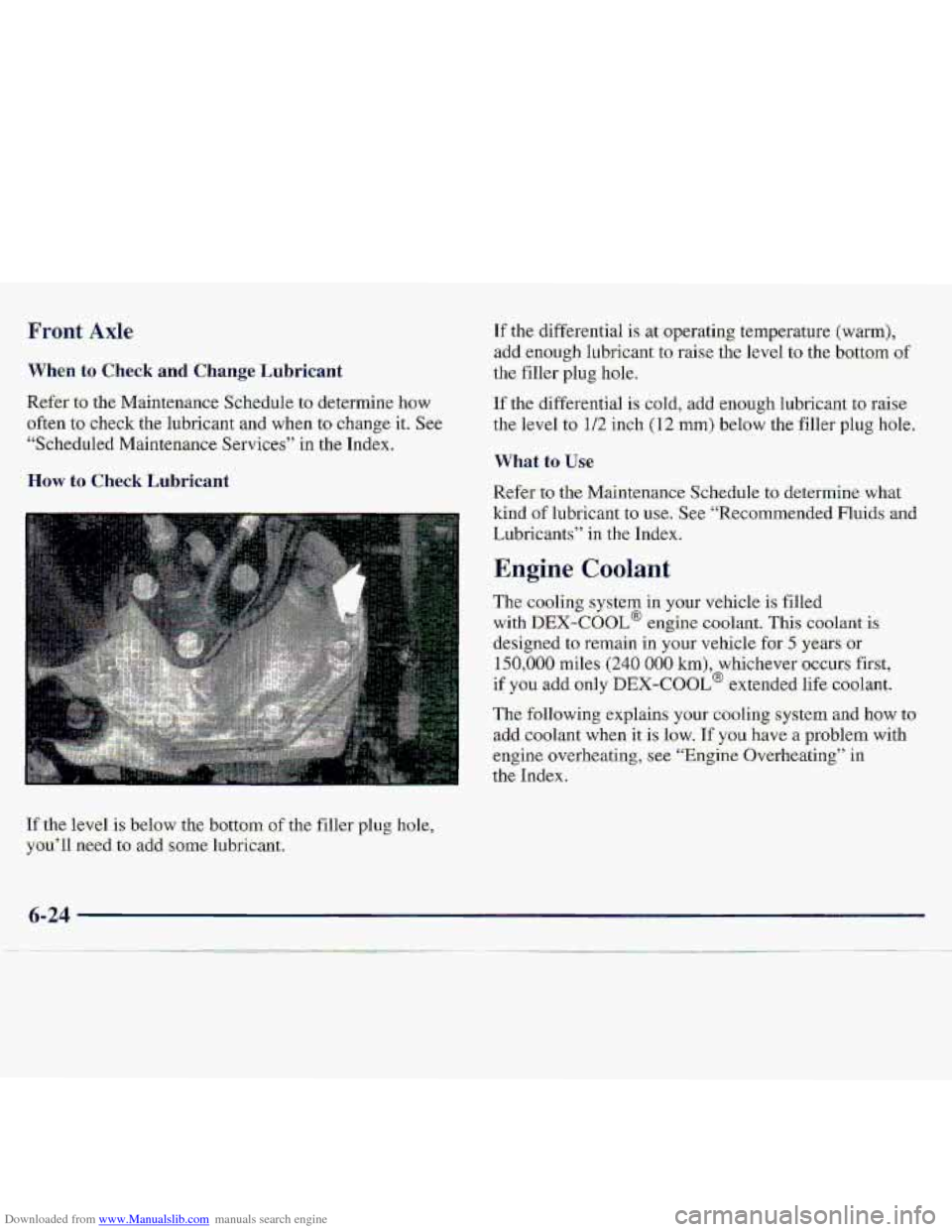Page 209 of 402
Downloaded from www.Manualslib.com manuals search engine Engine Overheating
YQU will find a coolant temperature gage on your
vehicle’s instrument paneI.
ESteam Is Coming FroniYour Engine
Steam from an overheatdengine can burn y.ou
badly, even if you just open the ho.od. Stay away
from the engine if you see or hear steam toming
from it. Just turn it off and get everyone away
from the vehicle until it cools down. Wait until
there is no sign of-steam or coolant before you
open the hood.
If you keep driving when your engine:is
overheated, the liquids in it can catch.fire. You
.or
others could be badly burned. Stop your engine if
it overheats,, and getmt of the vehicle until. the
engine
is cool.
NOTICE:
I
If your -engine catches fire. because you keep
driving with no co.olant, your vehicle can b.e
badly damaged. The costly repairs would..not. be
c~overed by your warranty.
5-12
Page 261 of 402

Downloaded from www.Manualslib.com manuals search engine Front Axle
When to Check and Change Lubricant
Referto the Maitltenance Schedule -to determine haw
often to check the lubricant and when to change it. See
“Scheduled Maintenance S-ervic-es” in the Index.
HOW to Check Lubricant
If the 1ev.el is below -the bottom of the filler plug hole,
youfll need to add some lubricant.
If the differential is at aperating temperature (warm),
add enough lubricant to ,raise the level to the bottom of
the filler plug hole,
If the differe.ntia1 is. cold, add enough lubricant to raise-
the level
to 1/2 inch ( 12 mm) below the filler plug hole.
What to Use
Refer to the Maintenance Schedule to determirie what
kind
of lubricant to use. See “Recommended Fluids and
Lubricants” in the Index.
Engine C,oolant
The cooling system in your vehicle is filled
with
DEX-COOL@ engine coolant. This coolant is
designed to remain in your vehicle for:5 year$ or
150,000 miles (240 000 km), whicheveroccurs first,
if you add only DEX-COOL@ extended life coolant.
The fdIowing explains
your .coaling system and how to
add coolant when
it is-10~~ If YQU have a problem with
engine overheating,
see “Engine Overheating’’ in
the Index.
6-24
Page 265 of 402
Downloaded from www.Manualslib.com manuals search engine Thermostat
NOTICE:
Your radiator cap is a 15 psi (105 kPa)
pressure-type cap and must be tightly installed to
prevent coolant loss and possible engine damage
from overheating. Be sure the arrows on the cap
line
up with the overflow tub.e on the radiator
filler neck.
Engine coolant temperature is controlled by a thermostat
in the engine
coolant sys-tem. The. thermostat stops the
flow of coolant through the radiator until the coolant
reaches a preset temperature.
Power Steering Fluid
6-28
Page 281 of 402
Downloaded from www.Manualslib.com manuals search engine 1 F
Poorly maintained and improp-erly used tires
are dangerous.
0 Overloading your tires can cause
overheating as a result
of too much, friction.
You could have an air-out and a serious
accident. See “Loading Your Vehicle” in
the Index.
CAUTION: (Continued)
Unaerinflated tires pose the same danger as
overloaded tires. The resulting-accident
could cause serious injury. Check all tires
frequently to maintain the recommended
pressure. Tire pressure should be checked
when your tires are cold.
cut, punctured
or broken by a sudden
impact
-- such as when you hit a pothole.
Keep tires at the recommended pressure.
0 Worn, old tires can cause accidents. If your
tread
is badly worn, or if your tires have
been damaged, replace them.
Overinflated tires are more likely to-be
6-44